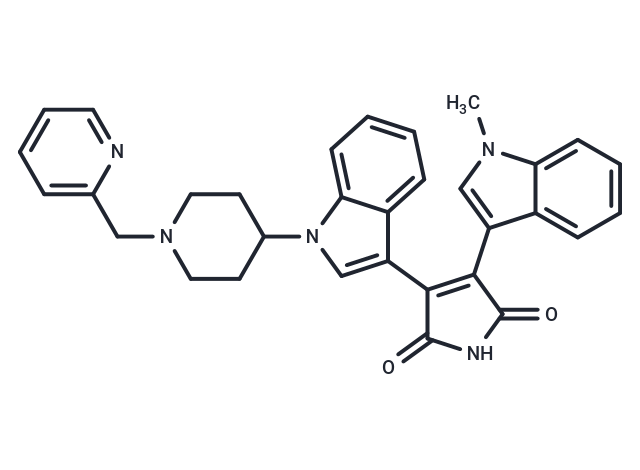Shopping Cart
- Remove All
 Your shopping cart is currently empty
Your shopping cart is currently empty

Enzastaurin (LY317615) (LY317615) is an effective PKCβ selective inhibitor (IC50: 6 nM), 6- to 20-fold selectivity against PKCα/γ/ε.

| Pack Size | Price | Availability | Quantity |
|---|---|---|---|
| 5 mg | $43 | In Stock | |
| 10 mg | $61 | In Stock | |
| 25 mg | $88 | In Stock | |
| 50 mg | $125 | In Stock | |
| 100 mg | $198 | In Stock | |
| 1 mL x 10 mM (in DMSO) | $48 | In Stock |
| Description | Enzastaurin (LY317615) (LY317615) is an effective PKCβ selective inhibitor (IC50: 6 nM), 6- to 20-fold selectivity against PKCα/γ/ε. |
| Targets&IC50 | PKCβ:6 nM |
| In vitro | Application of Enzastaurin consistently leads to significant dose-dependent growth inhibition in a variety of MM cell lines, including MM.1S, MM.1R, RPMI 8226 (RPMI), RPMI-Dox40 (Dox40), NCI-H929, KMS-11, OPM-2, and U266, achieving half-maximal inhibitory concentrations (IC50) ranging from 0.6 to 1.6 μM. This compound directly targets human tumor cells by promoting apoptosis and hindering cell proliferation. It specifically reduces the phosphorylation of GSK3βser9, ribosomal protein S6S240/244, and AKTThr308, while not affecting VEGFR phosphorylation. [1] Furthermore, Enzastaurin elevates apoptosis rates in CTCL's malignant lymphocytes and shows increased cytotoxicity when used alongside GSK3 inhibitors. A notable synergy is observed when Enzastaurin is combined with the GSK3 inhibitor AR-A014418, leading to raised levels of β-catenin total protein and its mediated transcription. Blocking this transcription or reducing β-catenin expression through shRNA achieves similar cytotoxic effects to the Enzastaurin and AR-A014418 combination. This treatment pair also notably diminishes mRNA levels and surface expression of CD44. [2] |
| In vivo | The combined treatment of xenografts with Enzastaurin and radiation resulted in a greater reduction in microvessel density compared to either treatment alone, correlating with delayed tumor growth. [3] |
| Kinase Assay | Kinase inhibition assays: The inhibition of PKCβII, PKCα, PKCε, or PKCγ activity by enzastaurin is determined using a filter plate assay format measuring 33P incorporation into myelin basic protein substrate. Reactions are done in 100 μL reaction volumes in 96-well polystyrene plates with final conditions as follows: 90 mM HEPES (pH 7.5), 0.001% Triton X-100, 4% DMSO, 5 mM MgCl2, 100 μM CaCl2, 0.1 mg/mL phosphatidylserine, 5 μg/mL diacetyl glyerol, 30 μM ATP, 0.005 μCi/μL 33ATP, 0.25 mg/mL myelin basic protein, serial dilutions of enzastaurin (1-2,000 nM), and recombinant human PKCβII, PKCα, PKCε, or PKCγ enzymes (390, 169, 719, or 128 pM, respectively). Reactions are started by addition of the enzyme and incubated at room temperature for 60 minutes. They are then quenched with 10% H3PO4, transferred to multiscreen anionic phosphocellulose 96-well filter plates, incubated for 30 to 90 minutes, filtered and washed with 4 volumes of 0.5% H3PO4 on a vacuum manifold. Scintillation cocktail is added and plates are read on a Microbeta scintillation counter. IC50 values are determined by fitting a three-variable logistic equation to the 10-point dose-response data using ActivityBase 4.0. |
| Cell Research | Induction of apoptosis by enzastaurin is measured by nucleosomal fragmentation and terminal deoxynucleotidyl transferase-mediated nick-end labeling (TUNEL) and staining in HCT116 and U87 mg cell lines. Briefly, 5 × 103 cells are plated per well in 96-well plates (1% FBS-supplemented media conditions), incubated with or without Enzastaurin for 48 to 72 hours. The absorbance values are normalized to those from control-treated cells to derive a nucleosomal enrichment factor at all concentrations as per the manufacturer's protocol. The concentrations studied ranges from 0.1 to 10 μM. In situ TUNEL staining is assayed with the In situ Cell Death Detection, Fluorescein kit. Cells (7.5 ×104) are plated per well in 6-well plates and incubated 72 hours in 1% FBS-supplemented media Enzastaurin. Fluorescein-labeled DNA strand breaks are detected with the BD epics flow cytometer. Ten thousand, single-cell, FITC-staining events are collected for each test. (Only for Reference) |
| Alias | LY317615 |
| Molecular Weight | 515.6 |
| Formula | C32H29N5O2 |
| Cas No. | 170364-57-5 |
| Smiles | O=C1C(C=2C=3C(N(C2)C4CCN(CC5=CC=CC=N5)CC4)=CC=CC3)=C(C(=O)N1)C=6C=7C(N(C)C6)=CC=CC7 |
| Relative Density. | 1.34 g/cm3 |
| Storage | store at low temperature | Powder: -20°C for 3 years | In solvent: -80°C for 1 year | Shipping with blue ice. | |||||||||||||||||||||||||
| Solubility Information | DMSO: 10.3 mg/mL (20 mM) | |||||||||||||||||||||||||
Solution Preparation Table | ||||||||||||||||||||||||||
DMSO
| ||||||||||||||||||||||||||

Copyright © 2015-2024 TargetMol Chemicals Inc. All Rights Reserved.